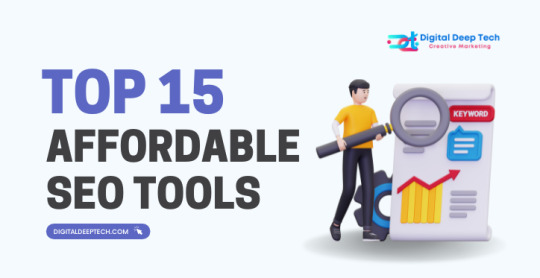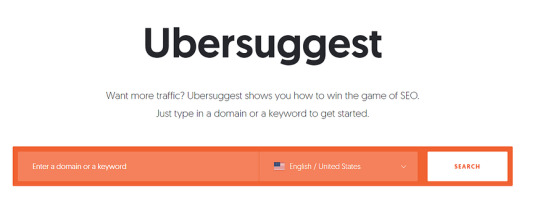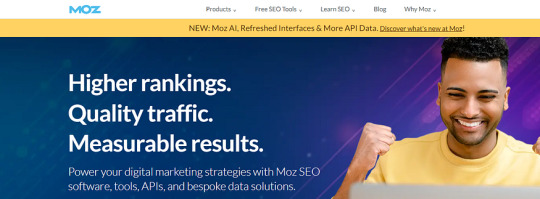#Keyword Research Strategies 2024
Explore tagged Tumblr posts
Text
The Ultimate Guide to Keyword Research Strategies for SEO Success - 2024
Introduction
Knowing how to do effective keyword research is essential for any successful SEO strategy in the rapidly changing digital market. The link between the stuff you offer and what people are searching for is created by keywords. But how can you make sure your content stands out in this large ocean of keywords? Don't worry; we'll go deep into keyword research tactics to give you the skills and information you need to push your website to the top of search engine results pages.
Fundamentals of Keyword Research:
It's important to grasp the fundamentals before tumbling into the sea of keywords. The words or phrases people enter into search engines to find information are known as keywords. Finding these terms through effective keyword research can help you optimize your content for increased visibility and relevance.
How Can I Get Ideas for Keyword Research?
Finding profitable keyword ideas is a combination of data analysis and imagination. Start by coming up with ideas for subjects related to your industry or niche. Then, make use of keyword research tools to add to your list and find undiscovered treasures that complement your content objectives.
9 Keyword Research Tools ( Free & Paid )
Google Keyword Planner:
A free tool that helps you find profitable keywords for your content by giving you information on search traffic, competition, and trends for keywords.
SEMrush:
With its extensive toolkit of SEO tools, SEMrush enables you to monitor your rankings, analyze competitors, and perform in-depth keyword research.
Ahrefs:
Distinguished by its vast database, Ahrefs assists you in finding new keywords, examining backlinks, and tracking the effectiveness of your website.
Moz Keyword Explorer:
This tool from Moz makes it easier to identify high-potential keywords for your SEO efforts with features like keyword difficulty and SERP research.
UberSuggest:
UberSuggest A simple-to-use tool that helps you improve your keyword strategy by offering suggestions for keywords, information on search volume, and competition analysis.
KeywordTool.io:
This tool provides insightful information about user intent by generating long-tail term ideas based on autocomplete data from search engines.
SpyFu:
With a focus on competitor analysis, SpyFu gives you the ability to obtain an advantage over your rivals by identifying the most lucrative keywords and advertising tactics.
LongTailPro:
This tool simplifies the process of conducting keyword research by concentrating on long-tail keywords. It makes it simpler to find low-competition, high-converting keywords.
AnswerThePublic:
AnswerThePublic generates original keyword suggestions based on user inquiries, prepositions, and comparisons by visualizing search query data.
Keyword Difficulty:
Prioritizing your keyword goals requires an understanding of keyword difficulty. This statistic evaluates a keyword's competitiveness by taking into account variables such as search traffic and the strength of rival pages. To get the most out of your SEO efforts, strike a balance between keywords with a high search volume and those with reasonable competition.
How Can I Select a Keyword?
Think about things like competitiveness, search volume, and relevancy when choosing keywords for your content. Choose keywords that balance popularity and attainability, keeping in mind the nature of your material and the aim of your audience. To increase your chances of appearing higher in search results and getting highly focused traffic, concentrate on long-tail keywords as well.
7 Advanced Tips and Strategies:
Utilize Keywords for Latent Semantic Indexing (LSI):
To increase semantic relevance and diversity in your keyword strategy, include synonyms and similar terms.
Examine SERP Elements:
Examine search engine results pages (SERPs) to find knowledge panels, featured snippets, and other rich snippets. Then, customize your material to make it more visible.
Utilize Content Generated by Users:
Keep an eye on forums, social media, and online communities to find current themes and user-generated keywords related to your business.
Perform Seasonal Keyword Research:
To match your content to the news and interests of your audience, anticipate seasonal trends and make use of relevant keywords.
Optimize for Voice Search:
In order to reach voice search consumers, make sure your material is optimized for conversational keywords and natural language searches, given the increasing popularity of voice-activated devices.
Prioritize User Intent:
Recognize the purpose of user inquiries (such as informational, navigational, or transactional) in order to personalize your content and offer solutions with additional value.
Keep an eye on and refine:
Keep an eye on the performance of your keywords, keep tabs on rankings, and adjust your approach in response to changing trends and insights from analytics data.
Conclusion
Keyword research is a dynamic, iterative process that calls for a combination of creativity, strategic planning, and data analysis. By using the strategies outlined in this article and the necessary resources, you may fully realise the potential of keyword research to improve visibility, produce organic traffic, and ultimately succeed in search engine optimisation. Your website's search engine rankings will soar to new heights if you keep learning and making adjustments.
Read more of our blogs
#keywords research#keywords research tool#keywords research strategy#Keyword Research Strategies 2024#Keywords Research Best Practices 2024
0 notes
Text
Keyword Phoenix - SNATCH PAGE 1 RANKINGS USING ZERO BACKLINKS - Discover Hyper Targeted Keywords that RANK FAST
[et_pb_section bb_built=”1″][et_pb_row][et_pb_column type=”4_4″][et_pb_text _builder_version=”4.23.1″ background_pattern_color=”rgba(0,0,0,0.2)” background_mask_color=”#ffffff” text_text_shadow_horizontal_length=”text_text_shadow_style,%91object Object%93″ text_text_shadow_horizontal_length_tablet=”0px” text_text_shadow_vertical_length=”text_text_shadow_style,%91object Object%93″…
#Easy Google ranking#Fast keyword ranking#High-converting keywords#Hyper-targeted keywords#keyword phoenix#Keyword research strategy#Long-tail keywords for SEO#Low competition keywords#On-page SEO optimization.#Organic traffic boost#Page 1 ranking strategy#Quick SEO wins#Rank keywords fast#Rank on Google fast#Rank without backlinks#SEO hacks 2024#SEO strategy for small businesses#SEO tips for beginners#SEO without backlinks#SEO without link building#Zero backlinks SEO
0 notes
Text
Supercharge Your SEO with Smart AI Integration
Discover how AI can revolutionize your SEO strategy.
In today’s fast-paced digital world, keeping your website ahead of the pack takes more than the usual SEO tricks. Artificial intelligence (AI) is now a game-changer in search engine optimization, transforming how businesses approach their online strategies. This guide dives into smart AI integration secrets to give your SEO a powerful boost and help your site shine. Why AI is a Big Deal in…
#AI content creation#AI in SEO#AI personalization#AI SEO benefits#AI SEO integration#AI tools for SEO#AI-driven SEO tools#AI-enhanced SEO#AI-powered UX#artificial intelligence in SEO#boost your SEO#Content Optimization#keyword research with AI#rank higher with AI#SEO automation#SEO ranking tools#SEO strategy 2024#SEO trends 2024#smart AI for SEO#technical SEO
0 notes
Text
The Future of XMLTV in the Digital Landscape of 2024

As we navigate through 2024, the digital entertainment landscape continues to evolve at a rapid pace. Amidst the plethora of content delivery formats, XMLTV stands as a significant tool for electronic program guides (EPGs) and other applications requiring TV listings. In this blog post, we will explore the future of xmltv epg source and delve into how search engine optimization (SEO) and digital marketing strategies can be effectively incorporated into the XMLTV framework to ensure maximum visibility and user engagement.
Understanding XMLTV in the Current Digital Ecosystem
XMLTV is a standard for TV listings that is used by a variety of applications to display up-to-date programming information. Despite the rise of on-demand streaming services, XMLTV remains relevant for traditional broadcast and cable television, as well as for IPTV and other emerging platforms that offer live TV options.
SEO Optimization for XMLTV
Optimizing XMLTV for search engines is crucial for reaching the widest possible audience. Here’s how you can ensure that your xmltv guide data are SEO-friendly:
Keyword Research
Identify Relevant Keywords: Focus on keywords that potential users might search for, including the names of shows, channels, genres, and specific airing times.
Use Long-Tail Keywords: These are more specific and less competitive, which can help in ranking higher for niche queries.
Metadata and Tags
Title Tags: Incorporate relevant keywords into the title tags of your XMLTV files. This helps search engines understand what the content is about.
Meta Descriptions: Write clear and concise meta descriptions for your XMLTV listings that include targeted keywords.
Schema Markup: Use this to provide search engines with detailed information about the TV listings, such as the time, channel, and program names.
Content Quality and Freshness
Regular Updates: Keep the XMLTV files updated with the latest programming to ensure that the content remains fresh, which is favored by search engines.
Unique Content: Make sure the descriptions within the XMLTV are unique and not just copied from other sources.
Digital Marketing Strategies for XMLTV

To enhance the reach and effectiveness of xmltv guide, integrating digital marketing strategies is essential.
Social Media Integration
Share Updates: Use social media platforms to share updates about new and popular TV shows or changes in the schedule.
Engage with Viewers: Create interactive content that encourages viewers to engage with the listings, such as polls or trivia related to the shows.
Email Marketing
Newsletter Subscriptions: Offer a subscription service for viewers to receive personalized TV guides via email, tailored to their interests.
Segmentation: Use segmentation to send targeted emails with listings that align with the preferences of different audience segments.
Partnerships and Collaborations
Work with TV Networks: Collaborate with television networks to get exclusive content or early listings that can be promoted as a USP (Unique Selling Proposition).
Syndication: Syndicate your xmltv listings with other online TV guide services to expand reach.
Analytics and Performance Tracking
Monitor Traffic: Use analytics tools to track the traffic to your XMLTV listings and understand user behavior.
SEO Performance: Regularly check your rankings for targeted keywords and optimize accordingly.
The relevance of XMLTV in 2024 is multifaceted, catering not only to traditional TV viewers but also to users of digital platforms seeking a comprehensive TV guide.
Gathering insights into the importance of anchors link building in seo and robust digital marketing strategies in the XMLTV framework, content creators can ensure that their listings are not only visible but also engaging for viewers. As we look toward the future, the integration of technology and strategic marketing will continue to play a pivotal role in the evolution of television content delivery.
The key to success with XMLTV lies in the ability to adapt and innovate, ensuring that the content meets the dynamic demands of the modern user while staying ahead in the competitive digital space. By following the guidelines provided, XMLTV providers can optimize their presence and offer a valuable service to viewers worldwide.
youtube
10 notes
·
View notes
Text
Effective Strategies to Increase Organic Website Traffic in 2024
The digital landscape and growing organic website traffic is crucial for businesses seeking a competitive edge. Organic traffic, or the users who find your site via unpaid search engine results, often translates into high-quality leads and sustained growth. By focusing on strategies that emphasize relevance, user experience, and search engine optimization (SEO), you can steadily increase organic website traffic and attract engaged visitors. Here’s a look at some proven methods to drive organic traffic effectively in 2024.
1. Optimize for User-Centric Content
The cornerstone of attracting organic website traffic is creating high-quality, user-centered content. In 2024, search engines like Google prioritize websites that deliver helpful, valuable information. Identify the questions, pain points, and interests of your target audience, and tailor your content to address these needs comprehensively. This approach not only keeps visitors on your page longer but also encourages them to explore more of your site.
Utilize blog posts, guides, and case studies to present your expertise. Engaging content naturally leads to higher rankings, which can help increase organic website traffic significantly.
2. Conduct Keyword Research
Keyword research remains a fundamental part of SEO. Finding the right keywords to focus on can directly impact your website’s visibility in search results. Tools like Ahrefs, SEMrush, and Google Keyword Planner can help identify high-volume, low-competition keywords relevant to your niche.
When choosing keywords, look for phrases that your target audience is likely searching for. Incorporate these strategically into your content, titles, and meta descriptions. By doing so, your site is more likely to appear in search results and increase organic website traffic as a result.
3. Leverage Long-Tail Keywords
Long-tail keywords are often more specific and usually face less competition. While these keywords may attract lower search volumes, they are highly targeted, often leading to better engagement and higher conversions. For instance, instead of targeting a broad term like "digital marketing," you might focus on "digital marketing for small businesses" or "digital marketing tips for startups."
Using long-tail keywords effectively allows you to connect with users looking for niche information, helping you stand out among competitors and increase organic website traffic over time.
4. Improve Website Load Speed and Mobile Optimization
A fast-loading, mobile-friendly website is essential for retaining visitors. Search engines like Google use website speed and mobile responsiveness as key ranking factors. Websites that take more than a few seconds to load can experience high bounce rates, meaning users leave the page without interacting further.
Improving website speed through image compression, minimizing redirects, and leveraging browser caching can make a significant difference. Also, ensure that your site’s design is responsive so that it performs well on mobile devices. This approach enhances user experience and can help increase organic website traffic as users are more likely to return to a site that loads quickly and is easy to navigate.
5. Optimize On-Page SEO Elements
On-page SEO involves optimizing individual pages to rank higher in search engine results. Important on-page elements include title tags, meta descriptions, headers, and internal links. Each of these elements should be optimized with relevant keywords, including your primary keyword, increase organic website traffic.
Make your titles descriptive and compelling, as this is often the first thing users see in search results. Meta descriptions should be concise, informative, and also include your target keywords. Internal linking—linking to other pages within your website—can guide visitors to related content, keep them on your site longer, and improve overall navigation.
6. Update and Repurpose Existing Content
Your existing content is a valuable asset. Regularly updating older posts with fresh information, improved readability, and current statistics can boost their ranking potential. Repurposing content—such as turning a blog post into a video or an infographic—can also expand your reach and bring in new visitors.
When you keep content fresh and relevant, it’s more likely to gain traction on search engines and social media, helping you increase organic website traffic without creating entirely new content each time.
7. Enhance User Experience (UX)
User experience (UX) is an increasingly important factor for search engines. A site that is easy to navigate, visually appealing, and provides value to users will generally rank higher. UX improvements, such as intuitive navigation, readable fonts, and engaging visuals, can significantly impact how visitors interact with your website.
A positive user experience encourages visitors to stay longer, reduces bounce rates, and increases the likelihood of visitors returning—all contributing to a boost in organic website traffic.
8. Build Backlinks from Reputable Sources
Backlinks, or links to your site from other websites, remain a vital part of SEO. Backlinks from reputable, high-authority websites act as endorsements for your site, signaling to search engines that your content is valuable. Reach out to industry-related sites, blogs, and influencers for guest posting opportunities or collaborations that can provide valuable backlinks.
Consistently working on your backlink profile helps increase organic website traffic by improving your website’s authority and search ranking.
9. Utilize Social Media for Content Distribution
While social media traffic itself isn’t classified as organic, it can indirectly help by increasing your content’s visibility and encouraging shares, which can lead to backlinks. Promoting your blog posts, videos, or other content on platforms where your audience is active can expand your reach and drive traffic back to your site.
When shared widely, high-quality content can gain traction, helping to increase organic website traffic as people discover and share your posts.
10. Track Your Analytics and Optimize
Regularly tracking your site’s performance through tools like Google Analytics and Google Search Console helps you understand what’s working and where there’s room for improvement. By identifying the types of content, keywords, and sources that drive the most traffic, you can make data-driven adjustments to your strategy.
Optimization based on performance insights is key to ongoing growth and can help increase organic website traffic steadily over time.
2 notes
·
View notes
Text
The Role of SEO in Driving Traffic: A Comprehensive Guide

Lets Know How The Role Of SEO Helps In Driving Traffic?
In today’s highly competitive digital landscape, every business is fighting for visibility. One of the most effective ways to increase your online presence and drive traffic to your website is through Search Engine Optimization (SEO). But what exactly is the role of SEO in driving traffic, and how can you leverage it to boost your digital marketing efforts? Let’s dive deep into how SEO works, its key components, and why it’s essential for traffic generation.
What is SEO?
SEO, or Search Engine Optimization, is the process of optimizing your website to rank higher in search engine results pages (SERPs). When a user searches for a keyword relevant to your business, SEO ensures that your website is among the first results they see. This increased visibility leads to more organic traffic—visitors who find your website naturally through search engines like Google, Bing, or Yahoo.
Why SEO is Crucial for Driving Traffic
Organic Traffic is Free Unlike paid advertising (PPC), SEO brings in visitors without direct cost per click. Once your website ranks well, you can continuously attract users without the need for ongoing ad spend. This makes it a cost-effective, long-term traffic generation strategy.
Users Trust Organic Results Studies show that users trust organic results more than paid ads. Ranking high organically increases the credibility of your website and brand. By appearing in the top results, you signal authority and relevance, encouraging users to click through.
Targeted Traffic SEO ensures that you are reaching users who are already searching for what you offer. These users are more likely to convert since they have a clear intent behind their search. For instance, someone searching for “best hiking boots” is likely to be in the market for purchasing hiking boots, and if your website ranks well, you can attract this targeted audience.
Key Components of SEO for Driving Traffic
To leverage SEO effectively, you need to focus on several core elements:
Keyword Research Keywords are the phrases and terms users search for online. Proper keyword research is crucial to understand what your target audience is searching for. Tools like Google Keyword Planner, SEMrush, or Ahrefs can help you identify the best keywords for your niche and there are some other tools are also available to know more on it click best digital marketing tools in 2024. Once identified, you can incorporate these keywords naturally into your content to ensure search engines recognize your relevance.
On-Page SEO This involves optimizing individual pages on your website to rank higher. On-page SEO focuses on keyword placement, meta tags, headers, and image optimization. Ensuring your website is user-friendly and loads quickly also plays a significant role in retaining visitors and reducing bounce rates.
Content Quality High-quality, engaging content that answers user queries is the foundation of SEO success. Search engines prioritize websites that provide value, which means your blog posts, product descriptions, and other content need to be well-written and informative. Aim to create long-form content that comprehensively covers topics in your niche.
Technical SEO Technical SEO ensures that search engines can easily crawl and index your website. It includes optimizing your website’s speed, mobile-friendliness, XML sitemaps, and ensuring proper URL structure. A well-optimized site makes it easier for search engines to understand your content and rank it accordingly.
Backlinks Backlinks are links from other websites that point to your site, acting as endorsements. The more high-quality backlinks you have, the more authority your website gains in the eyes of search engines. Building a solid backlink profile can significantly boost your site’s rankings and drive more traffic.
Local SEO If your business has a local focus, local SEO can be a game-changer. Optimizing your website for local searches (such as “coffee shop near me”) can bring in highly targeted traffic from your immediate area. This includes managing your Google Business Profile, collecting reviews, and optimizing for local keywords.
How SEO Drives Long-Term Traffic
One of the most significant benefits of SEO is its long-term traffic potential. While it may take time to see results, once your site ranks well, it can continue to bring in traffic for months or even years with minimal maintenance. Unlike PPC, where traffic stops as soon as the budget runs out, SEO has compounding effects.
Measuring SEO Success
Tracking your SEO efforts is crucial to ensure your strategy is working. Tools like Google Analytics and Google Search Console allow you to monitor your website’s traffic, keyword rankings, and user behavior. By analyzing this data, you can refine your SEO strategy and focus on what’s driving the most traffic.
Conclusion
SEO is a powerful tool for driving organic traffic to your website. From keyword research and on-page optimization to technical SEO and backlink building, each component plays a critical role in improving your search engine visibility. As a long-term strategy, SEO can deliver consistent, high-quality traffic that leads to higher conversions and business growth.
By mastering SEO, you’ll not only increase your traffic but also establish your brand’s authority in the digital space.
2 notes
·
View notes
Text
How Can You Optimize a Crypto Press Release for SEO and Visibility?

In the fast-paced world of cryptocurrency and blockchain technology, visibility is everything. Whether you’re launching a new token, announcing a major partnership, or promoting a decentralized finance (DeFi) project, crafting an effective press release is essential. However, a well-written crypto press release is only part of the equation. To maximize its impact, it must be optimized for search engines and visibility.
This blog will walk you through the key strategies for optimizing a crypto press release to boost its visibility and ensure it reaches the right audience. We'll cover essential SEO practices, writing techniques, distribution tips, and more to make your press release stand out in an increasingly competitive landscape.
1. Understanding the Importance of SEO in Crypto Press Releases
Search engine optimization (SEO) is a crucial factor in ensuring that your press release ranks high on search engines like Google. With the cryptocurrency market expanding rapidly, investors and enthusiasts rely on search engines to discover the latest updates and trends. If your press release isn’t optimized, it may get lost among thousands of similar announcements.
SEO optimization helps increase organic traffic to your press release, making it easier for journalists, bloggers, influencers, and potential investors to discover your project. The better optimized your press release is, the more likely it will be picked up by major publications and shared across various platforms.
Key Benefits of SEO Optimization for Crypto Press Releases:
Increased visibility on search engines and news outlets.
Higher ranking on Google News and other relevant platforms.
Improved click-through rates (CTR) from search engine results pages (SERPs).
Better engagement with readers and potential investors.
2. Choosing the Right Keywords for Your Crypto Press Release
One of the most fundamental aspects of optimizing a press release for SEO is keyword research. Using the right keywords ensures that your press release appears in relevant search results when people are looking for information related to your cryptocurrency project.
Steps to Effective Keyword Research:
Identify Your Target Audience: Understand who your target audience is. Are you targeting investors, developers, or cryptocurrency enthusiasts? Knowing your audience helps in selecting keywords that align with their search intent.
Use Keyword Research Tools: Tools like Google Keyword Planner, Ahrefs, and SEMrush can help you identify high-traffic keywords related to cryptocurrency. Focus on long-tail keywords (e.g., "best DeFi projects 2024" instead of "crypto project") as they often have lower competition and higher relevance.
Incorporate Relevant Crypto-Specific Keywords: Include terms like "blockchain," "cryptocurrency," "DeFi," "token launch," or "ICO" depending on your announcement. Ensure that you are also targeting trending keywords and phrases specific to your niche.
Avoid Keyword Stuffing: While it’s important to use relevant keywords, stuffing them unnaturally into the text can hurt readability and SEO. Aim for a natural flow in your writing while using keywords strategically in headings, subheadings, and body text.
Ideal Placement of Keywords:
Headline: Include the primary keyword to make it clear what the press release is about.
Subheadings: Use related keywords to break up the content and enhance SEO.
Introduction and Conclusion: Incorporate your primary keyword naturally within the opening and closing sections.
Meta Description: Summarize the press release with targeted keywords in 150-160 characters.
3. Crafting an SEO-Friendly Headline
The headline is the first thing people notice when they see your press release on a search engine or news site. Crafting a compelling, SEO-friendly headline is key to attracting attention and encouraging clicks.
Tips for an Effective Headline:
Include Keywords: Ensure that your main keyword appears within the first few words of your headline. This signals to search engines what the press release is about.
Keep It Concise: Search engines often truncate headlines that are too long. Aim for a headline length of 60-70 characters to ensure it displays properly.
Use Action Words: Words like “announces,” “launches,” “reveals,” or “partners” convey a sense of urgency and importance, prompting readers to click.
Highlight Value: Clearly communicate the value of the news. For example, "XYZ Token Launches Revolutionary DeFi Platform Offering 10% Staking Rewards."
Example:
"ABC Crypto Launches Groundbreaking NFT Marketplace, Aiming for 2025 Global Adoption"
"XYZ Token Announces Strategic Partnership with Leading Blockchain Firm"
4. Structuring the Content for Maximum Readability and Engagement
The structure of your press release not only affects readability but also plays a role in SEO. Properly formatted content is easier for search engines to crawl and index, improving your ranking potential.
Tips for Structuring Your Press Release:
Inverted Pyramid Style: Present the most important information first. Start with the "who, what, when, where, and why" to grab the reader’s attention and follow with supporting details.
Use Subheadings: Break up long blocks of text with subheadings that include secondary keywords. This enhances the user experience and helps search engines understand the content structure.
Bullet Points and Numbered Lists: These elements make the content more scannable and improve readability, which can lead to lower bounce rates.
Keep Sentences and Paragraphs Short: Avoid long, dense paragraphs. Aim for clear and concise language, as this makes the content easier to digest.
Key Sections to Include:
Headline: As mentioned earlier, should be SEO-optimized and attention-grabbing.
Subheadline: A concise follow-up that summarizes the news.
Introduction: Provide a brief overview of the announcement.
Body: Go into more detail about the project, partnership, or product launch. Include quotes from key figures and additional context to make the press release compelling.
Conclusion: Summarize the key points and add a call to action (CTA), such as visiting the website, joining a community, or attending an event.
5. Utilizing Backlinks to Boost SEO
Backlinks (inbound links) are another critical component of press release optimization. When high-authority websites link to your press release, it signals to search engines that your content is valuable and trustworthy, improving its ranking.
How to Maximize the Impact of Backlinks:
Link to Your Website: Always include a link back to your official website, landing page, or the specific product/service mentioned in the press release. Use descriptive anchor text like "Read more about our DeFi platform" instead of generic phrases like "click here."
Incorporate Relevant External Links: If your press release mentions other organizations, events, or tools, link to their official websites. This adds context to your announcement and boosts SEO.
Encourage Sharing: Make it easy for readers, influencers, and journalists to share your press release by including social media sharing buttons or embeddable links.
6. Writing a Compelling Meta Description
The meta description is the short snippet that appears below your headline on search engine results pages. Though not a direct ranking factor, a well-crafted meta description can improve click-through rates, indirectly influencing SEO.
Best Practices for Meta Descriptions:
Keep It Concise: Meta descriptions should be around 150-160 characters to ensure they display fully in search results.
Use Target Keywords: Incorporate your primary keyword naturally to boost relevance and visibility.
Add a CTA: Encourage the reader to click with phrases like "Learn more," "Discover now," or "Join us today."
Example:
"Discover how ABC Token's new blockchain platform revolutionizes DeFi staking. Learn more about our strategic partnerships and roadmap for 2025."
7. Leveraging Distribution Channels for Maximum Reach
Even the most well-optimized press release won't generate much visibility if it's not distributed effectively. Leveraging the right distribution channels is essential for getting your press release in front of the right audience.
Distribution Tips:
Submit to Crypto News Outlets: Sites like CoinTelegraph, CoinDesk, and CryptoSlate are popular platforms for crypto-related news. Ensure your press release is submitted to relevant publications.
Use Press Release Distribution Services: Services like PR Newswire, GlobeNewswire, and Business Wire offer targeted distribution to major news outlets, including crypto-specific channels.
Share on Social Media: Promote your press release on Twitter, LinkedIn, and cryptocurrency-focused platforms like Reddit. Use relevant hashtags and tag influential figures or publications in the crypto space.
Utilize Email Campaigns: If you have a newsletter, include your press release in your email campaigns to reach your existing audience.
Crypto Forums and Communities: Post your press release in popular crypto forums such as BitcoinTalk and other blockchain-related communities.
8. Monitoring and Measuring Success
Once your press release is live, it’s essential to track its performance to gauge its success. This data can help you refine your SEO and distribution strategies for future releases.
Key Metrics to Track:
Search Engine Ranking: Use tools like Google Analytics and SEMrush to monitor where your press release ranks for relevant keywords.
Traffic: Track the amount of traffic driven to your website or landing page from the press release.
Backlinks: Monitor the number of backlinks generated from your press release.
Engagement: Measure engagement metrics such as shares, likes, and comments on social media platforms.
Conclusion
Optimizing a crypto press release for SEO and visibility is a multi-faceted process that requires a combination of keyword research, content structuring, and strategic distribution. By following the guidelines outlined in this blog, you can increase the chances of your press release being discovered by the right audience and achieving its intended impact.
In the competitive world of cryptocurrency, where attention is fleeting, it’s essential to ensure your press release is not only well-written but also optimized for maximum visibility. Incorporate these strategies into your next press release, and you’ll be well on your way to driving traffic, engagement, and interest in your blockchain project.
2 notes
·
View notes
Text
SEO Marketing Plan 2024: A Comprehensive Guide
The landscape of digital marketing is continuously evolving, and as we move into 2024, staying ahead of the curve with a robust SEO marketing plan is more crucial than ever. This guide will walk you through the essential steps to create an effective SEO strategy that will drive organic traffic, boost your rankings, and ultimately grow your business.

Understanding the Importance of SEO in 2024 In 2024, SEO is more than just a tool for increasing visibility; it's a critical component of your overall marketing strategy. With search engines like Google becoming more sophisticated, optimizing your website for search has become increasingly complex. Yet, the rewards of a well-executed SEO plan—higher search rankings, more organic traffic, and increased conversions—make it worth the effort.
Setting Clear Goals for Your SEO Marketing Plan Before diving into the technical aspects of SEO, it's essential to define your goals. Are you looking to increase brand awareness, generate more leads, or improve sales? Setting clear, measurable objectives will guide your SEO efforts and help you track your progress over time.
2.1. SMART Goals Your SEO goals should be Specific, Measurable, Achievable, Relevant, and Time-bound (SMART). For instance, instead of a vague goal like "increase website traffic," aim for something more concrete like "increase organic traffic by 20% within six months."
Conducting a Comprehensive SEO Audit An SEO audit is the first step in understanding your website's current performance. This involves analyzing various factors such as site speed, mobile-friendliness, on-page SEO elements, and more. Tools like Google Analytics, Google Search Console, and SEMrush can help you identify areas for improvement.
3.1. Analyzing Your Website’s Technical SEO Technical SEO focuses on the backend structure of your website. Ensure your site is easily crawlable by search engines, has an XML sitemap, and is free of errors like broken links. Page speed and mobile optimization are also critical factors in 2024, as user experience continues to be a priority for search engines.
Keyword Research: The Foundation of SEO Keyword research remains the cornerstone of any successful SEO strategy. In 2024, the focus should be on finding long-tail keywords that align with user intent. Tools like Ahrefs, Moz, and Google Keyword Planner can help you discover keywords that are relevant to your industry and have the potential to drive significant traffic.
4.1. Understanding Search Intent Search intent is the reason behind a user's query. By understanding what your audience is looking for, you can tailor your content to meet their needs. Whether it's informational, navigational, or transactional intent, aligning your content with search intent will improve your chances of ranking higher.
Creating High-Quality, SEO-Optimized Content Content is king in the world of SEO. But in 2024, it's not just about creating any content—it's about creating high-quality, SEO-optimized content that provides value to your audience. This includes blog posts, articles, videos, infographics, and more.
5.1. Optimizing On-Page Elements Optimize on-page elements such as title tags, meta descriptions, headers, and images to ensure your content is SEO-friendly. Use your target keywords naturally within your content, but avoid keyword stuffing, which can hurt your rankings.
5.2. E-A-T: Expertise, Authoritativeness, Trustworthiness Google’s E-A-T principle is more important than ever in 2024. Your content should demonstrate expertise, authoritativeness, and trustworthiness. This can be achieved by backing up your claims with credible sources, showcasing your credentials, and providing accurate, up-to-date information.
Building a Strong Backlink Profile Backlinks remain a significant ranking factor in 2024. However, the focus should be on quality over quantity. Aim to acquire backlinks from reputable, high-authority websites in your industry.
6.1. Guest Blogging and Outreach Guest blogging and outreach are effective ways to build backlinks. Contributing valuable content to other websites can earn backlinks that enhance your site’s authority and visibility.
6.2. Avoiding Toxic Backlinks Not all backlinks are beneficial. Toxic backlinks from spammy or irrelevant sites can harm your SEO efforts. Regularly audit your backlink profile to identify and disavow any harmful links.
Leveraging Local SEO If you operate a local business, local SEO should be a key part of your marketing plan in 2024. Optimizing your Google My Business profile, acquiring local backlinks, and ensuring your NAP (Name, Address, Phone Number) information is consistent across directories are critical steps.
7.1. Local Keyword Optimization Include local keywords in your content to capture search traffic from users in your area. For example, if you run a bakery in New York, terms like “best bakery in New York” can help you rank higher in local searches.
Embracing AI and Machine Learning AI and machine learning are playing a growing role in SEO. Tools like RankBrain are helping Google understand search queries better than ever. As a result, optimizing for user experience and relevance has become more important than ever.
8.1. AI-Driven Content Optimization AI tools like SurferSEO and Clearscope can analyze top-performing content in your niche and provide insights into how you can optimize your own content to rank better. These tools consider factors like keyword usage, content structure, and readability.
Monitoring and Analyzing Your SEO Performance SEO is not a set-it-and-forget-it strategy. Regular monitoring and analysis are crucial to ensure your efforts are paying off. Use tools like Google Analytics, Search Console, and third-party SEO software to track key metrics like organic traffic, bounce rate, and conversions.
9.1. Adjusting Your Strategy Based on Data If something isn’t working, don’t be afraid to pivot. SEO is an ongoing process that requires flexibility. Regularly review your data and adjust your strategy to stay on track toward achieving your goals.
Conclusion Creating an effective SEO marketing plan for 2024 requires a combination of tried-and-true strategies and adaptation to new trends and technologies. By setting clear goals, conducting thorough research, optimizing your content, and staying on top of performance metrics, you can ensure that your SEO efforts will lead to success in the year ahead.
FAQs
What is the most important aspect of SEO in 2024? The most important aspect of SEO in 2024 is creating high-quality, user-centric content that aligns with search intent.
How often should I update my SEO strategy? You should review and update your SEO strategy at least every quarter to ensure it remains effective.
Are backlinks still important in 2024? Yes, backlinks are still crucial for SEO, but the focus should be on acquiring high-quality, relevant backlinks.
How can AI help with SEO? AI can help with SEO by analyzing data, optimizing content, and providing insights into user behavior and search trends.
What are long-tail keywords and why are they important? Long-tail keywords are longer, more specific phrases that users search for. They are important because they often have lower competition and higher conversion rates.
2 notes
·
View notes
Text
Common SEO Mistakes and How to Avoid Them
Common SEO Mistakes and How to Avoid Them
Introduction
In today's digital world, having a strong online presence is critical for business growth. Search Engine Optimization (SEO) plays a vital role in achieving this by boosting your website's ranking in search results. However, understanding the dynamic world of SEO may be challenging. That's where SEO Services come in, offering expert guidance to optimize your website and attract more organic traffic.
What Exactly Are SEO Services?
SEO services encompass a range of strategies professionals employ to enhance your website's visibility and search engine ranking. These are some of the main topics they cover:
Keyword Research: Identifying relevant keywords users search for to find your products or services.
On-Page Optimization: Fine-tuning website elements like title tags, meta descriptions, and content for optimal search engine understanding.
Technical SEO: Make sure your website can be indexed by search engines, loads quickly, and is compatible with mobile devices.
Content Strategy: Develop high-quality content that engages users, provides valuable information, and incorporates relevant keywords naturally.
Link Building: Acquiring backlinks from reputable websites to demonstrate your website's authority and expertise.
Local SEO: Optimizing your website for local searches if you cater to a specific geographic area.
SEO Analytics: Tracking website traffic, ranking performance, and making data-driven decisions to further optimize your strategy.
Benefits of Hiring SEO Services:
Expertise and Efficiency: Professionals possess in-depth knowledge of SEO best practices and the latest algorithms, saving you time and resources.
Improved Search Ranking: With a well-optimized website, you'll attract more organic traffic, leading to increased leads and sales.
Enhanced Brand Awareness: Higher visibility in search results translates to greater brand recognition and trust among potential customers.
Long-Term Growth: SEO is an ongoing process, and an SEO service provider can offer continuous monitoring and adjustments for sustained success.
Common SEO Mistakes to Avoid in 2024:
1. Keyword Stuffing: Overusing keywords unnaturally within your content results in a poor user experience and penalties from search engines. Focus on creating informative content with a natural flow of keywords.
2. Neglecting Mobile Optimization: With a significant portion of searches now conducted on mobile devices, a website that's not mobile-friendly is a major turnoff for users and search engines alike.
3. Ignoring Core Web Vitals: These Google metrics address loading speed, responsiveness, and visual stability. Poor Core Web Vitals will make it difficult for a website to rank well.
4. Low-Quality Content: Search engines prioritize websites with informative and engaging content. Avoid thin content with little value to users.
5. Backlink Spam: Building backlinks from irrelevant or low-quality websites can hurt your SEO performance. Focus on obtaining backlinks from established and trustworthy sources.
Staying Ahead of the Curve:
The world of SEO is constantly evolving. Here are some of the latest updates to be aware of:
Entity SEO: This approach focuses on establishing your website as an authority for specific topics by building connections with related entities in your field.
Voice Search Optimization: As voice search becomes more prevalent, optimizing your content for conversational language queries is crucial.
Focus on User Intent: Understanding the intent behind search queries allows you to tailor your content to provide users with the information they truly need.
Evolving Core Web Vitals: Google regularly refines its Core Web Vitals metrics, so staying updated on these changes is essential.
Conclusion:
Investing in professional SEO services can significantly improve your website's visibility and drive sustainable business growth. By avoiding common pitfalls and embracing the latest trends, you can navigate the ever-changing SEO landscape and achieve top rankings in search results.
#best digital marketing company#digital marketing company in india#digital marketing services#best social media marketing company in pune#seo services company#best social media marketing agency#best digital marketing company in pune
5 notes
·
View notes
Text
10 Game-Changing AI Tools Every Affiliate Marketer Needs to Dominate 2024

Affiliate marketing is evolving rapidly, and in 2024, AI tools are playing a pivotal role in shaping the industry. These tools are not just about efficiency—they’re about driving conversions, optimizing strategies, and significantly increasing your revenue.
Here are 10 game-changing AI tools that every affiliate marketer needs to dominate the market this year.
Unlock Your Affiliate Marketing Success!
Ready to boost your income? Grab my guide, "Affiliate Marketing Secret Formula," and discover the strategies top marketers use to dominate their niches. Learn how to find high-converting offers, leverage AI tools, and build a profitable affiliate business.
Get your copy now and start your journey to financial freedom
1. Seowriting.ai
Seowriting.ai is an AI-powered content creation tool designed to help affiliate marketers produce SEO-optimized content quickly and effectively. It streamlines the process of keyword research, content structuring, and readability enhancement, ensuring that your content ranks high and engages readers.
Why It’s a Game-Changer:
Automates keyword research and content optimization
Enhances readability and engagement
Improves content ranking potential
2. Jasper (Formerly Jarvis)
Jasper is an AI-powered writing assistant that aids in creating high-quality content tailored to your audience. It’s particularly useful for generating blog posts, product descriptions, and email campaigns that are both engaging and SEO-friendly.
Why It’s a Game-Changer:
Saves time on content creation
Ensures SEO-friendly copy
Customizable for different niches
3. VidIQ

VidIQ is an essential tool for affiliate marketers who leverage video content. It offers data-driven insights to optimize your YouTube videos, helping you rank higher and attract more viewers. VidIQ also provides competitive analysis and performance tracking to fine-tune your video marketing strategy.
Why It’s a Game-Changer:
Optimizes YouTube videos for better visibility
Provides competitive analysis
Tracks video performance and offers insights
4. Surfer SEO
Surfer SEO combines AI with data-driven insights to optimize your content for search engines. It provides real-time recommendations to help you out-rank competitors by improving on-page SEO.
Why It’s a Game-Changer:
Enhances on-page SEO
Provides actionable insights
Helps in outperforming competitors
Unlock Your Affiliate Marketing Success!
Ready to boost your income? Grab my guide, "Affiliate Marketing Secret Formula," and discover the strategies top marketers use to dominate their niches. Learn how to find high-converting offers, leverage AI tools, and build a profitable affiliate business.
Get your copy now and start your journey to financial freedom
5. ConvertKit
ConvertKit is an AI-driven email marketing platform that automates your campaigns, segments your audience, and personalizes your messaging to increase engagement and conversions.
Why It’s a Game-Changer:
Automates email sequences
Personalizes marketing efforts
Increases conversion rates
6. AdCreative.ai

AdCreative.ai uses AI to generate high-converting ad creatives for your affiliate campaigns. It’s perfect for marketers running ads on platforms like Facebook or Google, ensuring your creatives are optimized for performance.
Why It’s a Game-Changer:
Generates high-quality ad creatives
Boosts click-through rates (CTR)
Saves time on ad design
7. HubSpot CRM
HubSpot CRM uses AI to provide a comprehensive view of your customer interactions. It helps affiliate marketers track leads, manage relationships, and automate sales tasks, streamlining marketing efforts.
Why It’s a Game-Changer:
Automates customer relationship management
Improves lead tracking
Streamlines sales processes
8. Grammarly
Grammarly enhances your writing’s clarity, engagement, and readability. For affiliate marketers, this means producing polished, professional content that connects with your audience.
Why It’s a Game-Changer:
Improves content quality
Ensures clear and engaging copy
Enhances readability for better user experience
9. Ahrefs

Ahrefs is a powerful SEO tool that provides in-depth data on keyword rankings, backlinks, and competitor analysis. It’s indispensable for affiliate marketers looking to identify profitable keywords and outmaneuver the competition.
Why It’s a Game-Changer:
In-depth keyword research
Competitor analysis
Backlink tracking and analysis
10. Zapier
Zapier uses AI to automate workflows between different apps, allowing you to streamline repetitive tasks. It’s particularly useful for integrating multiple tools and automating your affiliate marketing processes.
Why It’s a Game-Changer:
Automates workflows
Integrates with hundreds of apps
Saves time on repetitive tasks
How AI Tools Are Revolutionizing Affiliate Marketing
AI tools in affiliate marketing are transforming the way we work by automating tasks, optimizing content, and enhancing customer interactions. The key to staying ahead in 2024 is to leverage these tools effectively.
Key Benefits of Using AI Tools:
Increased Efficiency: Automating repetitive tasks frees up time for strategic planning.
Enhanced Content Creation: AI-driven tools ensure your content is optimized and engaging.
Better Decision-Making: Data-driven insights help you make informed decisions that drive results.
Improved Customer Engagement: AI tools like chatbots and personalized email marketing increase customer satisfaction and loyalty.
Unlock Your Affiliate Marketing Success!
Ready to boost your income? Grab my guide, "Affiliate Marketing Secret Formula," and discover the strategies top marketers use to dominate their niches. Learn how to find high-converting offers, leverage AI tools, and build a profitable affiliate business.
Get your copy now and start your journey to financial freedom
Conclusion
The adoption of AI tools will be critical for affiliate marketers looking to succeed in 2024. The tools listed above, including Seowriting.ai and VidIQ, offer powerful features that can significantly enhance your marketing efforts. By integrating these technologies into your strategy, you can boost your efficiency, improve your content, and ultimately, dominate the affiliate marketing space this year.
Final Tip:
Start by integrating the AI tools that align most closely with your current needs. Gradually incorporate more tools as you grow, and continuously measure their effectiveness to optimize your strategy.
#affiliate marketing guide#affiliate marketing#affiliate promotion#affiliate products#passive income#ai#ai marketing tools#ai marketing platform
2 notes
·
View notes
Text
Mastering Digital Marketing in 2024: Essential Strategies for Success
As the digital landscape continues to evolve at a rapid pace, businesses must adapt their marketing strategies to stay relevant and competitive. The key to thriving in 2024 lies in understanding and implementing effective digital marketing practices that leverage the latest trends and technologies.
For individuals who want to work in the sector, a respectable Top Digital Marketing Course in Pune can give them the skills and information they need to succeed in this fast-paced atmosphere.

This comprehensive guide explores the essential strategies needed to create a robust digital marketing plan for the coming year, featuring clear, bold side headings for easy reference.
Define Clear Goals and Objectives
The foundation of any successful digital marketing strategy is setting clear and measurable goals. Start by identifying specific objectives that align with your business priorities, such as boosting website traffic, generating more leads, increasing sales, or enhancing brand awareness. Establish key performance indicators (KPIs) to track your progress and measure success. With well-defined goals, you can focus your resources on the most impactful activities, ensuring that every effort contributes to achieving your business objectives.
Gain Deep Audience Insights
Understanding your audience is crucial for crafting a targeted and effective marketing strategy. Develop detailed buyer personas that capture your audience's demographics, behaviors, preferences, and pain points. Conduct thorough market research and analyze data to create accurate and comprehensive personas. Audience segmentation allows you to tailor your messages and campaigns for different groups, improving relevance and engagement. By knowing your audience intimately, you can create more meaningful interactions that drive higher conversion rates and customer satisfaction.
Focus on High-Quality Content
Content remains a cornerstone of digital marketing success. Create valuable, high-quality content that addresses your audience’s needs and interests, including blog posts, videos, infographics, and podcasts. Use a content calendar to plan and schedule your content, ensuring consistent delivery and alignment with your marketing campaigns. A strong content marketing strategy not only attracts and engages your audience but also positions your brand as an industry authority, building trust and credibility over time.
Optimize for SEO and SEM
Search Engine Optimization (SEO) and Search Engine Marketing (SEM) are critical for increasing your online visibility. Optimize your website and content for search engines by focusing on keyword research, on-page SEO, technical SEO, and link building. Complement your organic efforts with paid search marketing (PPC) to drive targeted traffic to your website. By combining SEO and SEM, you can strengthen your online presence and make it easier for potential customers to find you, maximizing your reach and driving high-quality traffic.
It can be very beneficial in this situation to register in the Digital Marketing Online Certification.

Leverage Social Media Marketing
Effective social media marketing involves choosing the right platforms based on where your audience spends their time and tailoring your content accordingly. Engage with your audience through regular posts, stories, live videos, and interactions to build a community and enhance brand loyalty. Social media allows you to connect with your audience on a personal level, fostering relationships and encouraging user-generated content. Active participation in social media conversations humanizes your brand and provides valuable feedback to improve your products or services.
Utilize Data Analytics and Insights
Harnessing the power of data analytics is essential for tracking performance and making informed decisions. Use tools like Google Analytics, social media insights, and other analytics platforms to monitor key metrics and analyze data. This enables you to understand what’s working, identify areas for improvement, and make data-driven decisions. Regularly reviewing and interpreting data allows you to optimize your digital marketing strategy, allocate resources effectively, and achieve better results, ultimately driving higher ROI.
Embrace Personalization
Personalization is increasingly important in today’s digital marketing landscape. Use data and insights to tailor your marketing efforts, from personalized emails to targeted ads. Leverage AI and marketing automation to deliver personalized content at scale, enhancing customer engagement and satisfaction. By making your audience feel valued and understood, personalization strengthens connections and increases loyalty. Providing relevant and timely content improves the overall customer experience, boosts conversions, and drives long-term business growth.
Adopt an Omnichannel Approach
An integrated omnichannel approach ensures a seamless experience across all digital channels, including your website, email, social media, and mobile platforms. Maintain consistent messaging and branding across all touchpoints to provide a unified customer experience. An omnichannel strategy allows you to reach your audience wherever they are, delivering a cohesive and consistent journey. By integrating your marketing efforts, you create a holistic view of your customers, enabling you to deliver personalized and relevant interactions that drive engagement and loyalty.
Prioritize Mobile Optimization
With more users accessing the internet via smartphones and tablets, optimizing your website and content for mobile devices is crucial. Ensure your website is mobile-friendly, providing a seamless experience for mobile users. Incorporate mobile-specific strategies such as SMS marketing, app-based marketing, and mobile ads to reach users on the go. Mobile optimization not only improves user experience but also boosts your search engine rankings, as mobile-friendliness is a key ranking factor. Catering to mobile users helps capture a larger audience, increase engagement, and drive more conversions.
Enhance User Experience (UX)
Providing a positive user experience is essential for retaining and converting visitors. Ensure your website loads quickly, is easy to navigate, and offers a user-friendly interface. Make your digital properties accessible to all users, including those with disabilities, to expand your reach and improve user satisfaction. A well-designed website with intuitive navigation and fast load times enhances the overall user experience, reducing bounce rates and increasing the likelihood of conversions. Prioritizing UX builds trust and credibility, encouraging visitors to stay longer, explore your offerings, and become loyal customers.
Stay Innovative and Adapt
Keeping up with the latest trends and technologies in digital marketing is critical to staying ahead of the competition. Be willing to experiment with new strategies, platforms, and tools to find what works best for your brand. Innovation and adaptation are key to maintaining a competitive edge and continuously improving your marketing efforts. By embracing change and being open to new ideas, you can discover new opportunities, optimize your campaigns, and drive better results. Regularly evaluating and adapting your strategy ensures you remain agile and responsive to market shifts and customer needs.
Ensure Compliance and Privacy
Building trust with your audience requires a strong commitment to data protection and privacy. Ensure compliance with data protection regulations, such as GDPR and CCPA, and be transparent about your data collection and usage practices. Implement robust data security measures to safeguard personal information and demonstrate your commitment to privacy. By prioritizing compliance and transparency, you build a reputation as a trustworthy and responsible brand, enhancing customer confidence and loyalty. Staying compliant also helps you avoid legal issues and potential penalties, protecting your business from reputational damage and financial loss.
By incorporating these essential strategies into your digital marketing plan, you can effectively reach and engage your audience, achieve your business goals, and stay competitive in the dynamic digital landscape of 2024. A comprehensive approach that includes clear goals, deep audience insights, high-quality content, SEO and SEM, social media engagement, data analytics, personalization, an omnichannel strategy, mobile optimization, user experience enhancement, innovation, and compliance will position your brand for success. Embrace these elements and continuously refine your strategy to drive growth, enhance customer satisfaction, and achieve long-term success in the digital world.
#tech#training#digital marketing#digital marketing company#digital marketing course#online marketing#email marketing#search engine optimization#seo#seo services
3 notes
·
View notes
Text
Free Keyword Research Tool 2024 - Boost Your SEO Strategy
Explore the best free keyword research tools available in 2024 to enhance your SEO strategy and improve your website’s search engine ranking Free Keyword Research Tool – Boost Your SEO Strategy Introduction to Keyword Research Keyword research is a fundamental aspect of SEO (Search Engine Optimization). It involves identifying the words and phrases that people use when searching for information…
#digital marketing#keyword planner#keyword research#keyword research tool#search engine optimization#seo
2 notes
·
View notes
Text
the best seo tips for beginner 2024

Search Engine Optimization is an ever-evolving concept. you have to keep few points in mind that can boost your website without a cost, enlarge your brand awareness, increase a better conversion rate, build a relationship with the users, and so on. Here are some updated algorithm and strategies for beginners 2024:
Use Always update SEO trends and current updates.
Research quality keywords to have less competition.
Provide standard content.
Enhance Technical strategy for well interaction.
Use Social Media to reach a greater audience.
Use backlinks
Monitor and Analyse your webpage and techniques regularly
about more about click here :-https://upbstechnology.com/
2 notes
·
View notes
Text
Beginner's Guide: Mastering AI SEO Tools
Introduction SEO is crucial for driving organic traffic but can be overwhelming for beginners. AI tools like SEMrush and Ahrefs simplify the process, making it easier for newcomers to improve website performance. This guide covers everything from setting up tools to optimizing content, building links, and tracking progress. By the end, you’ll confidently enhance your SEO strategy. Learn more…
#Ahrefs#AI SEO tools#AI-driven SEO#backlink analysis#beginner SEO guide#best SEO tools 2024#Content Optimization#digital marketing tools#Google Search Console#keyword research#link building strategies#organic traffic#predictive analytics#primary keywords#SEMrush#SEO content suggestions#SEO for beginners#SEO performance tracking#SEO strategy#SEO tips#site audit#technical SEO tools#traffic analysis#WordPress SEO
0 notes
Text
Best 15 Cheap SEO Tools for Small Businesses in 2024
Introduction

Fortunately, many affordable SEO tools can help small businesses realize their marketing goals without spending much money on their activities. In this blog, we’ll take you through the best 15 affordable SEO tools that every small business should use in 2024, interpreting their features, benefits, and prices for you.
Below is an extension of the section “Top 15 Affordable SEO Tools for Small Businesses.” An elaboration on each tool will be done to provide more detailed information on features, benefits, pricing, and use cases.
The Best 15 Affordable SEO Tools for Small Businesses
Ubersuggest: Keyword Research and SEO Tool

Overview: Ubersuggest is a multi-purpose SEO tool developed by Neil Patel, containing a comprehensive suite of functionalities such as keyword research, site audits, and backlink data, among many others. It’s designed to help small businesses improve their SEO strategy efficiently.
Features and Benefits:
Keyword Research: It helps in generating keyword ideas that include search volume, competition, and CPC data. Site Audit: It helps in the identification and fixing of SEO issues with detailed reports. Backlink Analysis: Know your link profile and find new link opportunities. Content Ideas: As you know — Content is king, Get ideas for content based on top pages. Pricing Details: Has a free version; paid plans start at $20/month. Use Cases: Perfect for small businesses to give their keyword strategy a strong push, work on-site health, and have a strong backlink profile without spending too much on it.
2. Screaming Frog SEO Spider: SEO Audit Tool

Overview: Screaming Frog SEO Spider is a robust website crawler that helps you identify and fix technical SEO issues on your site for better performance in search engines.
Features and Benefits:
Web crawling: hunting for broken links, duplication, and other SEO problems. XML Sitemap Generation: Ability to produce sitemaps that would aid search engines in understanding the framework of your website. Integration: Works with both Google Analytics and Search Console. Custom Crawls: Customize your crawls to fit your specific requirements. Pricing: Free version; paid version costs $259 per year. Use Cases: It works best for businesses to carry out an intensive technical audit since the site search engine optimization is more important.
3. Moz Pro: All-in-One SEO Platform

Overview: Moz Pro is a set of SEO tools for getting a better and more accurate view of your position on search engines, including keyword research, SEO site analysis report, and link building.
Features and Benefits:
Keyword Research: Find and prioritize the right keywords for your site. Rank Tracking: Monitor your website’s search engine performance. Site Audits: Find and resolve issues that may be holding your website back. Link Analysis: Check into your link profile and monitor your efforts in link building. Pricing Details: Starting from $49 per month. Use Cases: This will satisfy a large portion of your SEO strategy honing, right from keyword research to link building.
4. Serpstat: All-in-One SEO Platform

Overview: Serpstat is armed with a large set of tools in the realm of SEO, PPC, and content marketing, which come in very handy for any small business.
Features:
Keyword Research: Identify high-performing keywords and analyze competitors. Competitor Analysis: Get insights about what works for competitors. Site Audit: Monitor and address the SEO issues present. Backlink Analysis: Perform backlink profiling and improvement. Rank Tracking: Monitor rankings across search engines. How Much: Starting at $600/month. Use Cases: Businesses that need an all-in-one tool that can address all facets of the game, from SEO to PPC to content marketing.
5. SpyFu: Competitive Research Tool

SpyFu has been designed to help businesses reveal their competition in both organic searches as well as in paid searches, giving genuine value to competitive analysis.
Features and Benefits:
Keywod Research: Find your competitors’ keywords Backlink analysis to know and track your backlinks Competitor Ad’s Paid Searches: How to uncover and copy key advertisers’ ad history Competitor Analysis: Compare your domain with your competitors to find the upside and risks. Pricing Details: Pricing starts at $39/month. Use Cases: Ideal for businesses looking to get ahead of the competition by knowing and utilizing competitors’ SEO and PPC strategies.
6. RankTracker: Keyword Tracking and Analysis
Overview: RankTracker offers accurate keyword tracking and analysis to trace your SEO campaigns and make informed decisions.
Features and Benefits:
Daily Keyword Rank Tracking: Trace performance for keywords daily. SEO Audit: Run comprehensive audits to identify and fix problems. Competitor Tracking: Monitor their ranking. SERP Analysis: Analyzing search engine results pages to get insight. Details: Pricing starts at $16 per month. Use Cases: Best for businesses with a requirement for accurate keyword tracking and a birds-eye view of complete SEO analysis to derive the optimization strategy.
7. Majestic: Backlink Analysis Tool
About: This is used to be a reliable name in backlink analysis and provides a deep analysis of your link profile.
Features and Benefits:
Backlink Data: Most extensive backlink database. Trust Flow and Citation Flow: Metrics devised to define how good and the number of backlinks there are. Link Context: Where are the backlinks placed in the referring page’s content? Compare with Competitors: Compare your backlink profile with that of competitors. Pricing Details: The basic plan can be found for $49.99/month. Use Cases: Ideal for businesses whose major focus is on building their backlink profile and extracting insights into their link-building efforts
8. Ahrefs: Comprehensive SEO Suite
Overview: Ahrefs is an ultimate SEO tool that promises extensive backlink analysis and keyword research.
Features and Benefits:
Backlink Analysis: Beacon on insightful data about your backlinks. Keyword Research: You can use a keyword database and analysis. Site Audit: It identifies and fixes the SEO problems. Content Analysis: Study content for better SEO performance. Rank Tracking: Keep a check on your search engine rankings. Price Detail: The plans start at $129 per month. Case Study: Suitable for businesses that require very strong tools in backlink analysis, keyword research, and overall site audits.
9. Surfer SEO: Best Content Optimization Tool
Overview: Surfer SEO will take care of content optimization, helping in better search engine rankings. It’s data-driven and provides real-time insights on what should be done.
Features and Benefits:
Content Editor: Hesitate no longer to operate inside an editor receiving real-time SEO suggestions while optimizing content. SERP Analysis: get assured about the search engine results for target keywords. SEO Audit: Deep-dive auditing to identify and rectify issues. Competitor Analysis: Benchmark your content against the top competitors. Pricing: Starting from $89/month. Use Cases: Ideal for businesses so hungry to squeeze their content better in search rankings that it seems like an obsession.
10. Google Search Console: Free SEO Tool
About: This is one of the prime things you should be using to track your website’s performance status on Google Search. This tool comes with an abundance of features that can be integrated into enhancing the SEO of your website.
Features and Benefits:
Performance Monitoring: Monitor the way your site is performing in search results. Index Coverage: See your indexed page. Detect Technical Issues: Discover and rectify all technical SEO issues. Sitemap: Submit sitemaps and individual URLs for crawling. Pricing Details: Free. Use Cases: A must-needed tool for any business that needs basic insights into website performance and maintenance of good SEO health.
11. Yoast SEO: SEO Plugin for WordPress
Overview: Yoast SEO is the most commonly used WordPress plugin to support users in their on-page SEO using varying functionalities and live content analysis.
Features and Benefits:
Live Content Analysis: You receive suggestions to make the SEO of your content better. XML Sitemaps: Automatically generated sitemaps. Readability Analysis: Improve the readability of your content with real-time feedback. SEO Analysis: Optimize your page for your target keywords. Free version: Starting at premium version pricing is $99/year. Use Cases: Perfect for use on WordPress when a user is willing to optimize on-page SEO without any hassle.
12. SEO PowerSuite: All-in-One SEO Software
Overview: SEO PowerSuite helps users get all necessary tools in one pack — Rank Tracker, WebSite Auditor, and LinkAssistant — for rank tracking, site audits, and link management.
Features and Benefits:
Rank Tracking: Keep an eye on your search engine rankings. Keyword Research: Do deep keyword research and analysis. Site Audit: Complete auditing of the website to find out the problems. Backlink Analysis: Backlinks analysis and monitoring. Pricing Details: Free version available; pro version starts at $299/year. Use Cases: Appropriate for businesses who are looking for a comprehensive SEO tool that takes care of the important aspects of SEO.
13. Answer the Public: Keyword Research Tool
Overview: Answer The public creates keyword ideas around users’ queries and then visualizes data.
Features and Benefits:
Visual Keyword Research: Get keyword ideas but in a visualized format. Content Gap: Discover content opportunities. User Queries: See questions that users are asking. Keyword Suggestion: Get a wide variety of keyword suggestions. Pricing Details: On offer is a free version; the pro version starts at $49 per month. Use Cases: Great for businesses looking to take their content strategy to the next level by tapping into the wants of users.
14. SEMrush: Online Visibility Management Platform
About: The SEMrush toolbox is loaded with solutions for SEO, PPC, content marketing, and social media. Users can experience an all-in-one answer to boosting visibility online.
Features and Benefits:
Keywords to Research: Access to one of the most extensive keyword databases and analysis available. Competitor Analysis: Competitors to Understand
Free Vs Paid SEO Tools
Both free and paid SEO tools have their importance. Free SEO tools like Google Search Console and Yoast SEO Pack come in free plans, but they provide only basic core functionality. These tools best serve people who are just getting started or those on very tight budgets. Paid SEO Tools: People will get advanced features, better support, and detailed data, leading to better SEO results if they invest in paid tools like Ahrefs or SEMrush.
How to Maximize the Use of Affordable SEO Tools
Below, you’ll find a guide to help you make the most of affordable programmatic SEO tools. i. Integrate multiple tools: Combine tools to include all SEO functions, from keyword research and site audit to backlink analysis. ii. Monitor regularly: Keep checking on your website’s performance and changing your SEO strategy where necessary. Stay updated: Gear yourself constantly with information about SEO trends and updates to help you enable tools and strategies that work with relevance.
Conclusion
Affordable SEO tools can largely change the whole game for small businesses, making their way up the search rankings without having to break the bank. You use the right tools and implement them properly, and you are likely to gain a lot in terms of SEO and, therefore, drive quality traffic to your website. Look through the tools mentioned in the blog below and get started strategizing your SEO plan for maximum optimization.
Frequently Asked Questions
1. What are some affordable SEO tools for beginners? Tools like Ubersuggest and Yoast SEO are user-friendly and encompass most of the fundamental requirements that most beginners need.
2. How do I choose the right SEO tool for my business? Evaluate your specific needs, compare features, and consider budget while choosing an SEO tool.
3. Are free SEO tools effective? Yes, even free ones like Google Search Console and Yoast SEO are both very effective, especially for small and beginner businesses.
4. Can cheap SEO tools compete with expensive ones? Most of the available affordable tools have quite strong features against the high-end tools, making them useful for small businesses.
5. How often should I use SEO tools? Many of the tools ask for frequent use. You can look at them daily or weekly to stay on top of your game and make changes when needed.
Affordable SEO tools done right can help small business owners create awesome results in SEO without breaking the bank. Get started right now and move into using these tools to start building your online presence!
2 notes
·
View notes
Text
Guide 2024 | Writing a Travel Blog? Learn tips and tricks.

Maintaining a travel blog is more than just an enjoyable way to look back on your adventures.
It might even be rewarding.
You can make money from your blog in a number of ways, which could lead to it becoming your main or supplementary source of income. If you've made the decision to start a travel blog, there are steps you can take to make sure it's successful and draws in sponsors, brands, travel writers, and public relations firms. Here's a step-by-step tutorial on starting and maintaining a profitable travel blog.
Step 1: Start with Research
You need to put some time into research before you start writing any of your content or even deciding on a name for your travel blog. The greatest place to start is by browsing the most well-liked travel blogs available and read them from go websites . Visit Blog section of Tripplanerpk.com to get good content.

Both the more recent travel bloggers who are gaining traction quickly and the more established travel bloggers who have enjoyed long-term success deserve your attention.
Make notes highlighting the similarities and unique features that set the top travel blogs apart. This covers elements like the writing style, page layout, image usage, and video. The objective is to observe what works and what doesn't, rather than to mimic the strategies of other bloggers, and to get general inspiration.
Step 2: Find a relevant niche
Keep this in mind when writing a travel blog Your idea should be clear about what information you are going to give in this blog. Your niche should be obvious, such as an adventure travel blog or a budget travel blog. Your intention should be clear about certain idea of blog that's what called a niche in blog writing.
Selecting a niche is essential for everything, from keywords to the URL, writing style, and how to incorporate images. Being hyper-focused on a niche is also important if you want your travel blog to gain the attention of travel companies or brands, so they can gauge how well your blog speaks to their target audience.
Step 3: Start writing

After completing your research, the next step will be to write and compose a blog. Use simple English as understood by a college boy and add some quotes to make it interesting . Try to be around your topic; avoid complications; just be formal.
Try to use relevant images in your blog that seek the attention of readers. Don't make it so long that the reader get bored reading it all. Check out other people Blogs and try to shape them newly.
Step 4: Publish
Last and the final step after completing you blog writting is to publish that . Its up to you where you want to publish your blog on your website or any other platform like medium ,linkedin , Or reddit. You can create our own website to share your personal experience or to share your knowledge with others.
Social media will play an essential role. Use social media platforms to gain traffic and to share your blog to your connections it will help your blog rank good in both marketing your travel blog to readers and networking with others within the travel community.
Friend and Follow as many travel professionals as you can find, and post consistently to help gain more followers in your niche – and to show travel professionals your level of dedication, and ability to generate attention.
4 notes
·
View notes